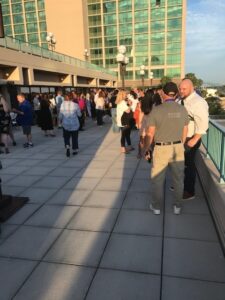How does a regional planning council plan for and demonstrate local climate resilience in a state like Florida? One answer is diligence—establishing clear goals and the means of measuring progress toward achieving them, even in the face of some political skepticism and, in some cases, opposition to effective planning tools. For those of us involved in the film project of the APA Hazard Mitigation and Disaster Recovery Planning Division, Planning to Turn the Tide: Creating Resilient Communities, this brought us back to Florida one more time right after Labor Day. The occasion was the annual conference of the Florida Chapter of the American Planning Association, which took place at the Hyatt Regency Jacksonville from September 5-8.
But first, I wanted to offer a short note for readers on why there has been a longer gap between posts on this blog since September. Two main factors delayed this article, which will, I hope, restore the earlier pace. The first was surgery. I was aware since last spring that medical developments would probably lead to prostate surgery, though I only learned in August what type of surgery and what it would mean. It took place on September 29, and I am still emerging from a variety of activity and dietary restrictions that followed during the recovery period. I may write about that more fully later, but it kept me out of circulation for about a month. The second was a week-long trip to Texas, for reasons similar to the Florida trips, that began with my arrival in Houston on November 7. We recorded additional blog videos in Texas, along with a dozen interviews for the movie, and you will read and hear about that in coming weeks.
Click here for a video summary of our interviews in Jacksonville.
One impetus for our trip to Jacksonville was that the Florida Chapter extended a gracious invitation and welcome to our team early in the summer, encouraging us to attend and film at the conference, and providing accommodations to do so, including a press pass for our videographer, David Taylor, and a room next to the staff office for the conference in which we conducted the interviews. They were and have been fully supportive of our undertaking and helped forge a working partnership with our division that we have used as a model with other chapters subsequently. We are very grateful to Florida APA President Whit Blanton and the chapter staff for their assistance and their understanding of the value of what we are trying to accomplish.
The other primary impetus was a need to fill in the gaps in the story we had already recorded about Florida’s natural hazard challenges and struggle to confront the impacts of climate change, sea level rise, and rapid urban growth. We had learned, for instance, from staff at the Tampa Baby Regional Planning Council that they had borrowed lessons in resilience planning from the Southeast Florida Regional Climate Change Compact, a four-county consortium that was the first to tackle the impacts of climate change on a multi-county regional basis. Their leadership is not surprising when one considers the high stakes of climate change, such as increased impacts of storm surge from hurricanes when coupled with sea level rise, or increased salt-water intrusion into groundwater sources, among other considerations. The potential ramifications involve billions of dollars in climate-resilient infrastructure investments over coming decades. That sort of problem, when faced realistically, absolutely demands visionary planning.
So, we decided to identify and interview some of the best and most experienced planners addressing these issues. The Florida APA conference afforded a certain efficiency in finding many of these people in the same place at the same time, but it also let us learn that the Northeast Florida Regional Council, based in Jacksonville, is adapting its own lessons in resilience in a part of the state that once tended to see itself as immune to the sorts of major coastal storms that afflict most of Florida. Now they are seeking to confront and prepare for such eventualities. In each region that begins to adapt resilience planning to its own needs, experience with such approaches grows, and Florida gets steadily smarter in its strategies for coping with its environmental challenges, even as population growth and new urban development continue to raise the bar. The challenge is relentless, but progress is essential.
To support the HMDR film-making effort, use either the donations link here or the QR code below. We will acknowledge all donors, whose help we greatly appreciate. Make this your film too as we move forward.
Jim Schwab

